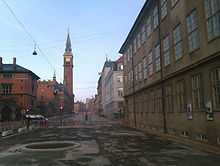Vester Voldgade

Vester Voldgade (lit. English: West Rampart Street) is a street in Copenhagen, Denmark which runs from Jarmers Plads to the waterfront between Frederiksholms Kanal and Langebro, passing the City Hall Square on the way.
Together with Nørre Voldgade and Øster Voldgade it forms a traffic artery which arches around the Zealand side of central Copenhagen all the way to Oslo Plads where it continues as Folke Bernadottes Allé along the western and northern periphery of Kastellet.
History
.jpg)
Vester Voldgade was originally a narrow alley which ran along the inner margin of Copenhagen's West Rampart, part of the Bastioned Fortification Ring which enclosed Copenhagen.
.jpg)
The city's haymarket was located at the site of the current City Hall Square until the New Haymarket was inaugurated om 1 January 1888. The section from the haymarket to the harbor was originally known as Filosofgangen (English: Philosopher's Path). That section of the ramparts was one of the last to be decommissioned, surviving until 1885.[1] Lange Bridge was located at the far end of the street until 1903 when it was moved to the end of Vestre Boulevard (now H. C. Andersens Boulevard).
Current reconstruction
The section of Vestervoldgade which runs from the City Hall Square to the waterfront is currently being redeveloped as a green promenade. The plan concentrates car traffic in two lanes instead of four also covers Dantes Plads which connects the street to H. C. Andersens Boulevard in front of the Ny Carlsberg Glyptotek. It is designed by the architectural firm COBE and GHB Landskabsarkitekter.[2]
Notable buildings and residents
The low yellow building at No. 119 is a former hay storage from about 1799, part of the Royal Horse Guards Barracks. The building was originally considerably longer but was shortened when Thorvald Jørgensen's Post Giro Building (No. 133) was built in 1838.[3] The 45-bay, half-timbered building on the other side of the Post Giro Building, part of Fæstningens Materialgård, a former military storage facility, is from 1748.
Vester Voldgade School(89) was completed in 1890 to a design by Ludvig Fenger. It has housed Den Classenske Legatskole since 1938.[4] The low building on the corner of Stormgade (Stormgade 18( was the first home of Overformynderiet m which later moved to a new building on Jolmens Kanal. The building was designed by Hans Jørgen Holm and is from 1884.[5]
-
The Classen School
-

Hotel København
References
- ↑ "Vester Voldgade" (in Danish). indenforvoldene.dk. Retrieved 2013-11-08.
- ↑ "Vester Voldgade". Københavns Kommune. Retrieved 2011-02-16.
- ↑ "Vester Voldgade 119a-b-123/Frederiksholms Kanal 26-28" (in Danish). indenforvoldene.dk. Retrieved 2013-11-08.
- ↑ "Skolens historie fra 1725 til 1993:" (in Danish). Den Classenske Legatskole. Retrieved 2013-11-08.
- ↑ "Sag: Overformynderiet (tidl.)" (in Danish). Kulturstyrelsen. Retrieved 2014-01-03.
External links
| Wikimedia Commons has media related to Vester Voldgade. |
External links
- Plan of the new promenade and square
Coordinates: 55°40′30″N 12°34′19″E / 55.67500°N 12.57194°E

